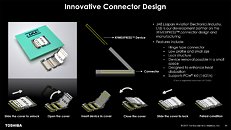- Joined
- Oct 9, 2007
- Messages
- 47,499 (7.49/day)
- Location
- Hyderabad, India
| System Name | RBMK-1000 |
|---|---|
| Processor | AMD Ryzen 7 5700G |
| Motherboard | ASUS ROG Strix B450-E Gaming |
| Cooling | DeepCool Gammax L240 V2 |
| Memory | 2x 8GB G.Skill Sniper X |
| Video Card(s) | Palit GeForce RTX 2080 SUPER GameRock |
| Storage | Western Digital Black NVMe 512GB |
| Display(s) | BenQ 1440p 60 Hz 27-inch |
| Case | Corsair Carbide 100R |
| Audio Device(s) | ASUS SupremeFX S1220A |
| Power Supply | Cooler Master MWE Gold 650W |
| Mouse | ASUS ROG Strix Impact |
| Keyboard | Gamdias Hermes E2 |
| Software | Windows 11 Pro |
Toshiba Memory today announced XFMExpress, a new standard of socketed internal non-volatile memory for use in thin-and-light consumer electronics, ultra-thin notebooks, and IoT devices. XFMExpress seeks to solve the increasing problem of repairability of thin-and-light devices, in which the SSD is hardwired onto the device's mainboard and non-replaceable. Toshiba believes M.2 doesn't fully meet the Z-height requirements of today's thin-and-light device designers, and hence there is need for a new space-saving storage device standard that remains internal to the device, but allows for repairability by swapping out the storage device.
This does not compete with SD Express, as it is not being pushed as a removable storage solution, but rather an internal storage device that's easy to replace. The XFMExpress effort consists of two components, the XFMExpress card, which has roughly similar dimensions to an SD card (14 mm x 18 mm x 1.4 mm), but performance and capacity rivaling full-fledged M.2 NVMe SSDs; and a new socket Toshiba designed in partnership with JAE (Japan Aviation Electronics corp). This socket, made of steel and contact points that have been directly soldered onto the device's mainboard, is an LGA, with a thin (<0.2 mm thick) retention brace.




The XFMExpress standard uses PCI-Express x4 as its physical layer, and the NVMe protocol, requiring no additional drivers for NVMe-aware operating systems and firmware. The standard currently uses PCI-Express gen 3.0 x4, but will incorporate PCI-Express gen 4.0 x4 "very soon." Under the hood, an XFMExpress module has a controller, a DRAM cache, and stacked 3D NAND flash, and is capable of utilizing the interface bandwidth to the fullest.



View at TechPowerUp Main Site
This does not compete with SD Express, as it is not being pushed as a removable storage solution, but rather an internal storage device that's easy to replace. The XFMExpress effort consists of two components, the XFMExpress card, which has roughly similar dimensions to an SD card (14 mm x 18 mm x 1.4 mm), but performance and capacity rivaling full-fledged M.2 NVMe SSDs; and a new socket Toshiba designed in partnership with JAE (Japan Aviation Electronics corp). This socket, made of steel and contact points that have been directly soldered onto the device's mainboard, is an LGA, with a thin (<0.2 mm thick) retention brace.




The XFMExpress standard uses PCI-Express x4 as its physical layer, and the NVMe protocol, requiring no additional drivers for NVMe-aware operating systems and firmware. The standard currently uses PCI-Express gen 3.0 x4, but will incorporate PCI-Express gen 4.0 x4 "very soon." Under the hood, an XFMExpress module has a controller, a DRAM cache, and stacked 3D NAND flash, and is capable of utilizing the interface bandwidth to the fullest.



View at TechPowerUp Main Site







